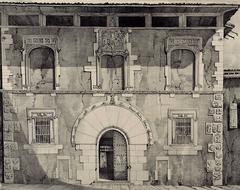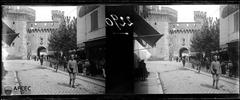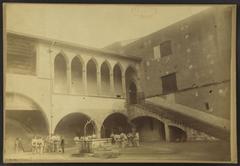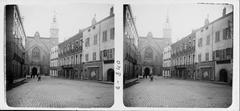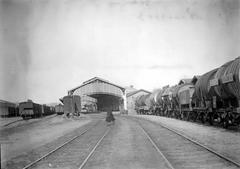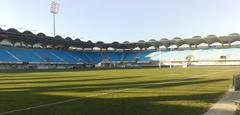Ruscino Archaeological Museum, Perpignan: Visiting Hours, Tickets, and Comprehensive Guide
Date: 14/06/2025
Introduction: Discover the Legacy of Ruscino
Perched atop a commanding promontory overlooking the Têt valley near Perpignan, France, the Ruscino Archaeological Museum and its ancient site stand as a testament to over 3,000 years of continuous human presence. Ruscino’s story weaves together the Neolithic era, the rise of tribal societies, Mediterranean trade, Roman urbanization, and the eventual transition into medieval Perpignan. Today, the museum serves as a dynamic educational and cultural resource, offering immersive exhibits, guided tours, and panoramic views that transport visitors into the heart of southern France’s layered past.
Whether you are a history buff, a student, or a curious traveler, Ruscino offers a unique window into the region’s evolution, from early settlements to its role as a hub of commerce and culture. This guide provides all the practical information you need—visiting hours, ticketing, accessibility details—alongside expert recommendations for making the most of your visit and exploring nearby attractions.
For up-to-date details, consult official resources such as Perpignan Méditerranée Tourisme, WhichMuseum, and POP Culture Gouv.
Contents
- Introduction
- Historical and Cultural Background
- Archaeological Discoveries and Museum Highlights
- Visiting Information: Hours, Tickets, and Access
- Visitor Experience and Practical Tips
- Nearby Attractions
- Frequently Asked Questions (FAQ)
- Conclusion and Useful Links
- Sources
Historical and Cultural Background
Origins: From Neolithic Settlement to Tribal Capital
Ruscino’s earliest traces date to the Neolithic period, with evidence of settled farming and herding communities as early as the 6th millennium BCE. By the Bronze and Iron Ages, the site became a thriving center for the Elisyces and Sordes tribes, who capitalized on Ruscino’s fertile plains and strategic location for regional trade.
A Mediterranean Crossroads
During the 6th century BCE, Ruscino emerged as a fortified oppidum. The discovery of imported Etruscan ceramics and Greek amphorae attests to robust trade links across the Mediterranean, especially in wine and olive oil. These commercial relationships fostered cultural exchanges that shaped the settlement’s development (EXARC).
Romanization and Urban Transformation
The 2nd century BCE saw Ruscino’s incorporation into Gallia Narbonensis, marking the beginning of profound Roman influence. The city was restructured with orthogonal streets, public baths, a forum, and Latin inscriptions. Roman architectural techniques and urban planning left an indelible mark on the cityscape, and Ruscino flourished as a regional administrative and economic center (Academia.edu).
Decline and Medieval Transition
Following the collapse of the Western Roman Empire, Ruscino experienced a gradual decline, though it remained significant during Visigothic and Frankish periods. By the early Middle Ages, population and power shifted toward modern-day Perpignan, yet Ruscino’s name endures in “Roussillon,” a testament to its lasting legacy.
Archaeological Discoveries and Museum Highlights
Key Discoveries
Archaeological excavations, ongoing since the early 20th century, have unearthed:
- Neolithic and Bronze Age pottery
- Iron Age jewelry and tools
- Etruscan, Greek, and Roman ceramics
- Roman coins, inscriptions, and wine production equipment
- Defensive walls, forums, and houses
- Funerary monuments and burial goods
A particularly notable find is a lead commercial letter from the 6th century BCE—the earliest regional documentation of wine trade (whichmuseum.com).
Museum Experience
The Musée Archéologique de Ruscino, designed by François Fontès and Jean-Michel Wilmotte, combines modern Mediterranean-style architecture with thematic displays. Highlights include:
- Permanent exhibitions on the site’s evolution
- Interactive reconstructions of ancient life
- Artifacts ranging from daily domestic objects to luxury imports
- Educational workshops and family activities
- A belvedere terrace with sweeping views of the Roussillon plain
Visiting Ruscino: Hours, Tickets, and Accessibility
Location
Address: 5001F Chemin de Château Roussillon, Château-Roussillon, 66000 Perpignan, France
Ruscino is situated just east of central Perpignan, on a hilltop with excellent vantage points.
Opening Hours
- Days: Typically open Tuesday to Sunday
- Hours: 10:00 AM – 6:00 PM (last entry 5:30 PM)
- Closed: Mondays and public holidays
- Note: Hours may vary seasonally or for special events. Always confirm on WhichMuseum or Perpignan Méditerranée Tourisme.
Tickets
- Individual Entry: Free admission
- Guided Tours: Required for site access; book in advance through the Perpignan Tourist Office or by contacting [email protected], phone +33 4 68 67 47 17 (POP Culture Gouv)
- Group Visits: Welcome with prior booking
Getting There
- By Car: 15 minutes from Perpignan city center, free parking on-site
- By Public Transport: Local buses serve Château-Roussillon; check Perpignan public transport for current routes
- By Bicycle/On Foot: Suitable for active visitors—note the hilltop ascent
Accessibility
- The museum includes accessible paths and restrooms, but due to uneven terrain, visitors with limited mobility should contact ahead for assistance
- Free parking (including accessible spaces) is located near the entrance
Visitor Experience and Practical Tips
Booking and Planning
- Advance Booking: Essential due to guided tour requirements and limited opening times
- Language: Tours are primarily in French; English or other languages may be arranged with notice
What to Bring
- Footwear: Wear sturdy shoes for uneven surfaces
- Weather: Sun protection and water in summer; jacket in cooler months
- Photography: Allowed outdoors; check with guides for indoor rules
On-Site Etiquette
- Remain on marked paths and respect instructions to preserve the archaeological site
- Supervise children and maintain a quiet environment
Nearby Attractions
- Perpignan Historic Center: Explore the Palace of the Kings of Majorca, Cathedral of Saint John the Baptist, and the Casa Pairal Museum
- Local Cuisine: Sample Catalan dishes in Perpignan’s vibrant restaurants (The Crazy Tourist)
- Scenic Views: The museum’s belvedere terrace is ideal for panoramic photos
Frequently Asked Questions (FAQ)
Q: Is entry free?
A: Yes, but guided tours—required for access—must be booked in advance.
Q: What are the opening hours?
A: Usually Tuesday to Sunday, 10:00 AM–6:00 PM; check official sources for updates.
Q: Is the museum accessible for people with disabilities?
A: Yes, but the terrain is uneven; inquire in advance for support.
Q: Can I visit without a guided tour?
A: No, independent visits are not permitted to protect the site.
Q: Are English tours available?
A: Mostly in French, but English tours may be arranged with advance notice.
Conclusion: Plan Your Ruscino Adventure
The Ruscino Archaeological Museum and site offer a compelling journey through the ancient Mediterranean world and the roots of modern Perpignan. With its curated exhibitions, free admission, and expertly guided tours, Ruscino is essential for anyone seeking to understand the region’s heritage. For a seamless experience, book your tour in advance, prepare for the hilltop setting, and explore additional attractions in Perpignan for a full cultural immersion.
Enhance your visit with the Audiala app for audio guides, interactive maps, and updates. Stay connected via official museum channels and social media for news on events and new discoveries.
Related Articles
- Top Museums to Visit in Perpignan
- Exploring the History of Roussillon
- Best Outdoor Activities Near Perpignan

